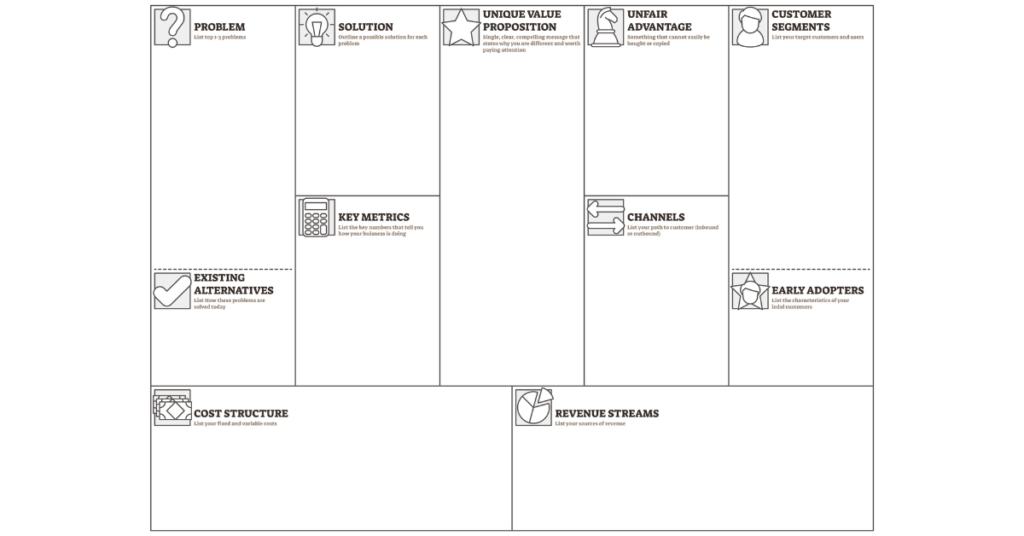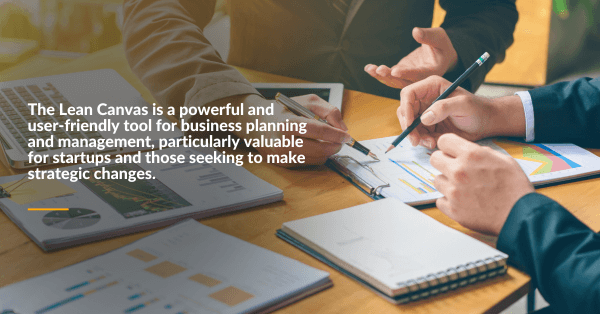The Lean Canvas is an easy-to-use and effective business planning and management tool that is used to explore opportunities and challenge assumptions. It’s a great way to start a business or to make key changes within an existing one. A Lean Canvas helps you to clarify your business model, to explore business ideas, to make better decisions, and to test the viability of those decisions. This blog is designed to be a quick introduction to what Lean Canvas is, what are some key metrics on Lean Canvas and how to use them to unlock business success.
What is a Lean Canvas
According to Study, The Lean Canvas is a one-page business plan designed for start-up entrepreneurs that focuses on high-risk factors and actionable items for start-up entrepreneurs. Lean Canvas was developed by Ash Maurya from Osterwalder’s original Business Model Canvas. It can be used to help validate and test different ideas as part of the start-up process.
Why is the Lean Canvas Important?
Before embarking on a new business venture, an entrepreneur has a great responsibility: transforming their vision into a communicable format. While the Business Model Canvas is recognized for its emphasis on transparent business planning, the Lean Canvas offers distinct advantages that deserve careful consideration.
Some of the advantages include:

1. It is great at problem-solving
The Lean Canvas simplifies the process of describing a problem-solution strategy on a single piece of paper. It offers entrepreneurs and business startups a valuable tool to gain perspective on their ideas and serves as a guiding framework for outlining their hypotheses. The primary objective of the Lean Canvas is to develop the business’s core value proposition and identify effective solutions for customer pain points. This approach enables individuals to visualize how their product or service effectively addresses a significant problem.
2. Provides Ideas That Actually Work
Similar to other business planning tools, the lean canvas model is derived from existing models. It shares a similar structure with the business model canvas but incorporates structural modifications to enhance its practicality and provide a distinct focus.
In contrast to other templates, the lean canvas offers a significant advantage by emphasizing actionable approaches to validate ideas and assess their alignment with business goals. Rather than primarily serving strategic alignments, this template is specifically designed to facilitate the validation process. Its collaborative nature enables the integration of multiple perspectives, thereby expanding the realm of possibilities for a company. This inclusive approach empowers individuals to express unique action items that can have a transformative impact.
3. Conveys Ideas Efficiently
According to fresco, The Lean Canvas is a template that helps entrepreneurs rapidly formulate and refine business concepts, develop product launches, identify the target market and establish key differentiators. Not only this but with the Lean Canvas, entrepreneurs can easily communicate with key stakeholders by communicating core business ideas or concepts efficiently. By using a Lean Canvas, you can convey ideas more effectively to your team and the outside world.
What are the key metrics on Lean Canvas?

The Lean Canvas is divided into nine key areas, each of which represents a crucial aspect of your business. These areas are:
- Problem
- Solution
- Key metrics
- Unique value proposition
- Unfair advantage
- Customer segments
- Channels
- Cost structure
- Revenue streams
Out of these nine areas, the key metrics section is perhaps the most important. This section is where you’ll identify the specific metrics that you need to track to measure your business’s success.
How to identify and measure key metrics on Lean Canvas
Identifying and measuring key metrics on Lean Canvas is a straightforward process. First, you’ll need to identify the specific metrics that are most important for your business. These might include things like customer acquisition cost, customer lifetime value, conversion rate, or churn rate.
Once you’ve identified your key metrics, you’ll need to track them over time. This can be done using a variety of tools, including spreadsheets, dashboards, or specialized analytics software. The most important thing is to be certain that you’re tracking your metrics as consistently and accurately as possible, so you can get a clear picture of how your business is performing.

How to use your Lean Canvas
The lean canvas is not just a validation tool but also a valuable resource for learning and decision-making. It enables you to track your progress, evaluate your outcomes, and identify both risks and opportunities. Moreover, the lean canvas is instrumental in effectively communicating your vision and strategy to your team and stakeholders, fostering alignment with your goals and priorities. Regularly updating your lean canvas is crucial, as it allows you to remain adaptable and responsive, ready to pivot or persevere based on the insights and discoveries you gather along the way.
Examples of key metrics for different types of businesses
The specific key metrics that you’ll need to track will depend on the type of business you’re running. Here are some examples of key metrics for different types of businesses:
- E-commerce: conversion rate, average order value, customer acquisition cost, shopping cart abandonment rate
- SaaS: customer acquisition cost, customer lifetime value, churn rate, monthly recurring revenue
- Mobile app: downloads, retention rate, daily active users, in-app purchases
These are just a few examples, and the specific metrics you’ll need to track will depend on your business model and goals.
Tools for tracking and analyzing key metrics on Lean Canvas
![]()
There are a lot of tools available for tracking and analyzing key metrics on Lean Canvas. Just to name a few:
- Google Analytics: This is a free tool that can help you track website traffic, conversion rates, and other key metrics.
- Mixpanel: This is a specialized analytics tool that can help you track user behavior and engagement in your app.
- Hubspot: This is a marketing automation tool that can help you track and analyze a variety of key metrics, including lead generation, customer acquisition cost, and conversion rates.
Common mistakes to avoid when working with key metrics
Working with key metrics can be challenging, and there are some common mistakes that entrepreneurs make when using the Lean Canvas. Here are a few to avoid:
- Focusing on the wrong metrics: It’s easy to get caught up in metrics that don’t really matter for your business. Make sure you’re focusing on the metrics that are most important for your goals.
- Overanalyzing data: It’s important to track your metrics consistently, but don’t get bogged down in data analysis. Make sure you’re taking action based on your data, not just analyzing it endlessly.
- Neglecting qualitative feedback: Metrics are important, but they don’t tell the whole story. Make sure you’re also soliciting qualitative feedback from your customers and stakeholders to get a more complete picture of how your business is performing.
Conclusion
There is no doubt that you will be able to achieve great things with a lean canvas, but you need to understand exactly what it is, and how it can benefit your business. We hope that after reading this blog post you feel a little more confident.

If you feel that this blog has been useful, please consider sharing it with others. We would really appreciate it if you could share it on your social media channels, or email it to a friend who may find it useful.
Thank you for reading, we are always excited when one of our posts is able to help businesses like yours.
Before you go, I want to offer you something. It is a 3-month 1:1 coaching accelerator program for anyone who wants to learn how to validate and launch their business idea the proper way. It is specifically designed to help you validate your business idea BEFORE you even start building your product or service.
Our weekly coaching calls will help you set goals and track your progress towards them.
At the end of the course, you will have a profitable business idea that you can take to the market. And not only that, but you will have a clear understanding of how to successfully pre-sell your digital product or service to your IDEAL audience.
It STOPS you from wasting your time, money, energy, and resources on building a business that WON’T ever sell.
You can read more about it here.
Now, I’d love to hear from you.
Did you find these steps on small business marketing helpful?
I want to know about your journey. Let me know in the comments below and as always feel free to contact me!






0 Comments